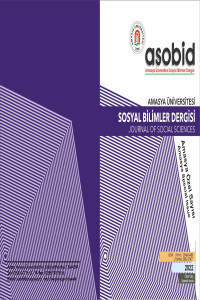APHRODİSİAS BULUNTUSU DEMETER/CERES RAHİBESİ’NE YENİ BİR DÖNEM ÖNERİSİ
Karia Bölgesi’nin önemli kentlerinden Aphrodisias’tan ele geçen ve bugün İstanbul Arkeoloji Müzeleri’nde sergilenen giyimli kadın heykeli, sol elinde tuttuğu atribütlerden dolayı Demeter/Ceres tipindeki portre heykel olarak yorumlanmıştır. Kimlik konusunda araştırmacıların hem fikir oldukları portre heykel, tarihlendirilme konusunda ise tartışmalıdır. Bu çalışmada da arkeoloji bilimine yeni kazandırılmış edinimler ve eldeki mevcut verilerle, bir kez daha irdelenen eserin etkilendiği hanedan mensubu ve onun portre tipi tanımlanmıştır. Böylelikle portre tipolojisini tanımlayan ve tarihlendiren kuaförlük modası, Flaviuslar Hanedanlığı’ndan, Nerva - Erken Traianus Dönemi (MS 1. yüzyıl sonuna) kadar açıklanmıştır. Süreklilik göstererek gelişen kuaförlük modasının gelişim evreleri de resmi kadın portre tipleri özelinde yorumlanmıştır. Bunun sonucunda da kadın heykelindeki süngerimsi saç kütlesinin oldukça ütopik şekli çelenkvari saç modası, çağdaşı kent Roma merkezli III. tipteki Domitia Longina portresiyle beraber çağdaşı kadın portresiyle de karşılaştırılarak Aphrodisias eseri için yeni bir dönem önerisi getirilmiştir.
Anahtar Kelimeler:
Aphrodisias, kadın, portre, MS 1. yüzyıl sonu
The statue of a dressed woman, found in Aphrodisias which is one of the important cities of Caria Region, and exhibited in Istanbul Archaeology Museums today, has been interpreted as a Demeter/Ceres type portrait sculpture since the attributes held in her left hand. The portrait sculpture which researchers agree about identity, becomes controversial when it comes to dating. In this study, the work has been examined once again by using the newly acquired acquisitions and existing data in archeology, and the dynasty member influenced by the work and its portrait type are defined. Thus, the hairdressing fashion, which defines and dates the portrait typology, has been explained from the Flavian dynasty to the Nerva-Early Traianus period (late 1st century AD). The development stages of the hairdressing fashion that develops continuously are interpreted in the form of formal female portrait types. As a result, a new period was proposed for Aphrodisian piece by comparing the rather utopian shape of the spongy hair mass, the garland-like hair fashion on the woman statue with ther portrait of Domitia Longina in IIIrd type which was Rome centered-its contemporary city.
Keywords:
Aphrodisias, woman, portrait, late 1st century AD,
___
- Arlı, Yaşar (2020). Flaviuslar ve Traian Dönemleri Anadolu Portre Sanatı. Doktora Tezi, Antalya: Akdeniz Üniversitesi Sosyal Bilimler Enstitüsü.
- Arsan, Nimet (1946). Anadolu’nun M.S. I. ve II. yüzyıllarına ait Giyimli ve Ayakta Duran Kadınlar. Belleten 10,39, s. 425-469.
- Bernoulli, Johann Jacob (1891). Römische Ikonographie: Die Bildnisse der Römischen Kaiser II. Von Galba bis Commodus. Stuttgart, Berlin, Leipzig: Union Deutsche Verlagsgesellschaft.
- Erim, Kenan Tevfik (1986). Aphrodisias: City of Venüs Aphrodite. London: Blond&White Limited.
- Frel, Jiri ve Morgan, Sandra Knudsen (1981). The J. Paul Getty Museum: Roman Portraits. Los Angeles: Philbrook Art Center and The J. Paul Getty Museum.
- Gaudin, M. Paul (1906). “Seconde note su less fouilles exécutées á Aphrodisias”. Comptes rendus des séances de I’Académie des Inscriptions et Belles-Lettres 50, s. 158-184.
- İnan, Jale ve Rosenbaum, Elisabeth Alföldi (1966). Roman and Early Byzantine Portrait Sculpture in Asia Minor. Londra: The Oxford University Press.
- Lenaghan, Julia (2009). “Kadın Portre Heykelleri”. (Ed. R. R. R. Smith ve J. L. Lenaghan). Aphrodisias’tan Roma Portreleri: Roman Portraits from Aphrodisias. İstanbul: Yapı Kredi Yayınları, s. 86-101.
- Maderne-Lauter, Caterina (1999). “Das Porträt einer Römerin im Frankfurter Liebieghaus. Von der Bedeutung des, Stils”. (Ed. H. v. Steuben). Antike Porträts: Zum Gedächtnis von Helga von Heintze. Möhnesee: Bibliopolis.
- McDermott, William C. ve Orentzel, Anne E. (1979). Roman Portraits: The Flavian and Trajanic Period. Columbia and London: University of Missouri Press.
- Mendel, Gustave (1914). Musées Impériaux Ottomans: Catalogue des Sculptures Grecques, Romanies et Byzantines. Constantinople: En Vente au Musée Imperial.
- Özgan, Ramazan (2013). Roma Portre Sanatı II. İstanbul: Ege Yayınları.
- Rystedt, E. (1977). A Flavian Portrait Reconsidered. The Museum of Mediterranean and Near Eastern Antiquities MedelhavsMuseet, Bulletin 12, s. 70-72.
- Smith, Roland Ralph Redfern, Dillon, S., Hallet, C., vd. (2006). Aphrodisias II: Roman Portrait Statuary from Aphrodisias. Mainz: Verlag Philipp von Zabern.
- Varner, Eric R. (1995). Domitia Longina and the Politics of Portraiture. American Journal of Archaeolgy 99, 2, s. 187-206.
- Yıldırım, Bahadır (2009). “Aphrodisias Şehir ve Kamu Yapıları”. (Ed. R. R. R. Smith ve J. L. Lenaghan). Aphrodisias’tan Roma Portreleri: Roman Portraits from Aphrodisias. İstanbul: Yapı Kredi Yayınları, s. 35-54.
- Zoridis, Pandeli (1984). “Two New Roman Portraits from Athens”. American Journal of Archaeology 88, 4, s. 592-594.
- Wegner, Max (1966). Das Römische Herrscherbild: Die Flavier (Vespasian. Titus. Domitian. Nerva. Iulia Titi. Domitilla. Domitia). Berlin: Verlag Gebr. Mann.
- West, Robert (1941). Römische Porträt-Plastik II. Münih: F. Bruckmann K. G.
- ISSN: 2548-0480
- Yayın Aralığı: Yılda 2 Sayı
- Başlangıç: 2016
- Yayıncı: Amasya Üniversitesi
Sayıdaki Diğer Makaleler
LATÎFÎ’NİN MAZHARU’L-ACÂYİB’İNİN TÜRKÇE TÛTÎNÂME TERCÜMELERİ ARASINDAKİ YERİ
APHRODİSİAS BULUNTUSU DEMETER/CERES RAHİBESİ’NE YENİ BİR DÖNEM ÖNERİSİ
ORTAÇAĞ TÜRK-İSLÂM DEVLETLERİNDE NEVBET
AMASYA’YA GELEN YERLİ TURİSTLERİN AMASYA MUTFAĞINA YÖNELİK ALGILARININ BELİRLENMESİ
AMASYA SANCAĞINDA KARANTİNA TEŞKİLATININ KURULMASI, ORTAYA ÇIKAN SALGINLAR (1812-1918)
BİNBİR GECE MASALLARINDAN SEÇME HİKÂYELER: KÂTİP MUHAMMED’İN “HİKÂYE-İ DUHTERÂN-I ARABΔSİ
